Đạo hàm Malliavin của quá trình Bessel phân thứ dạng tổng quát
Bài báo này xem xét một dạng tổng quát của quá trình Bessel phân
thứ. Đây cũng là một dạng thuộc lớp các phương trình vi phân ngẫu
nhiên kỳ dị xác định bởi chuyển động Brown phân thứ đã được
nghiên cứu bởi một số tác giả. Với một số giả thiết của các hệ số,
phương trình này có nghiệm duy nhất dương. Mục đích chính của bài
báo là đưa ra công thức của đạo hàm Malliavin cho quá trình
này. Tính toán Malliavin được sử dụng cho phương trình vi phân
ngẫu nhiên xác định bởi chuyển động Brown phân thứ. Chúng ta
nhận được đạo hàm Malliavin cho quá trình này là một hàm mũ của
đạo hàm của hệ số dịch chuyển. Kết quả này rất hữu ích khi đánh giá
moment ngược của nghiệm. Từ đó chúng ta có thể đánh giá tốc độ
hội tụ của nghiệm xấp xỉ trong Lp
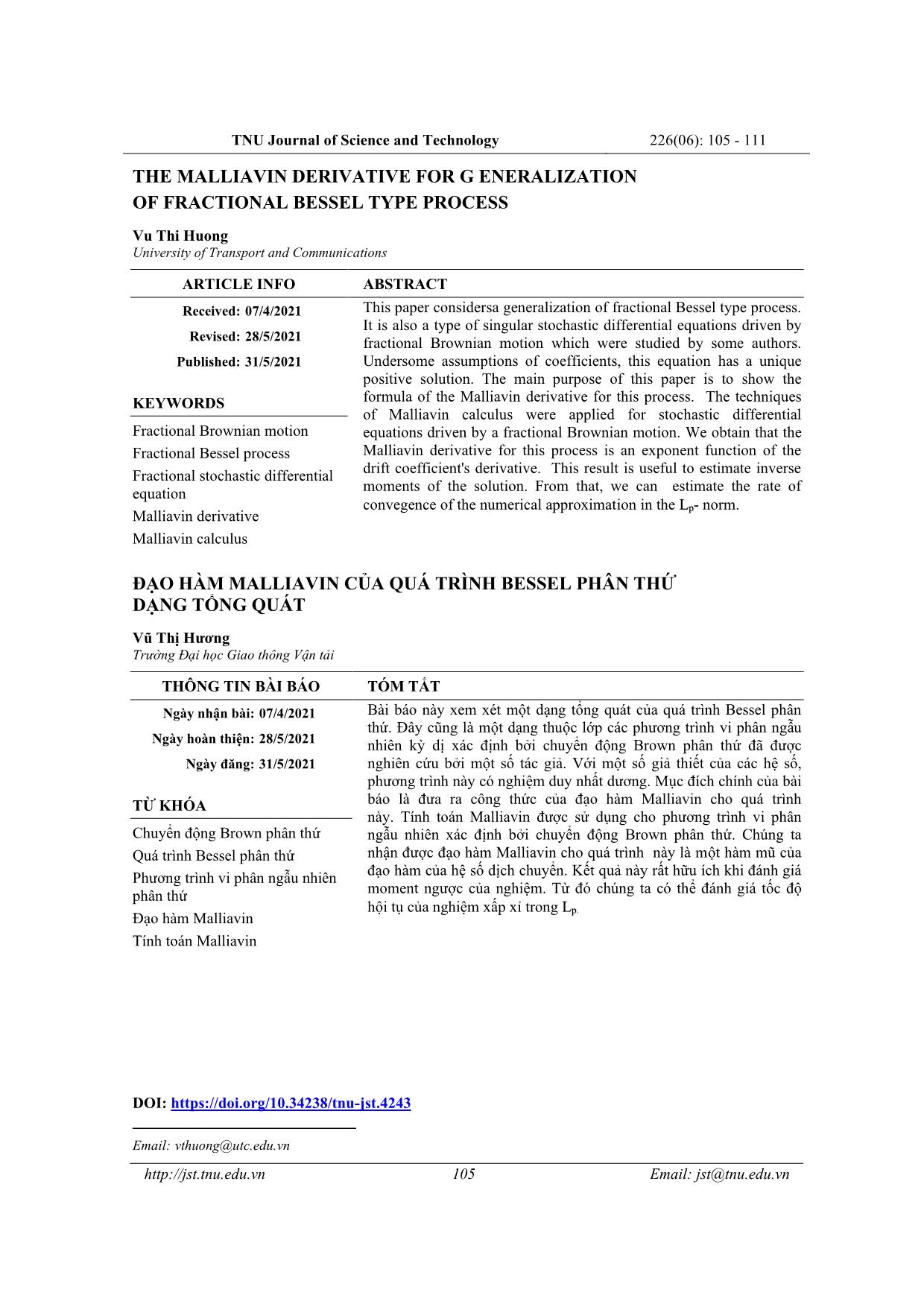
Trang 1
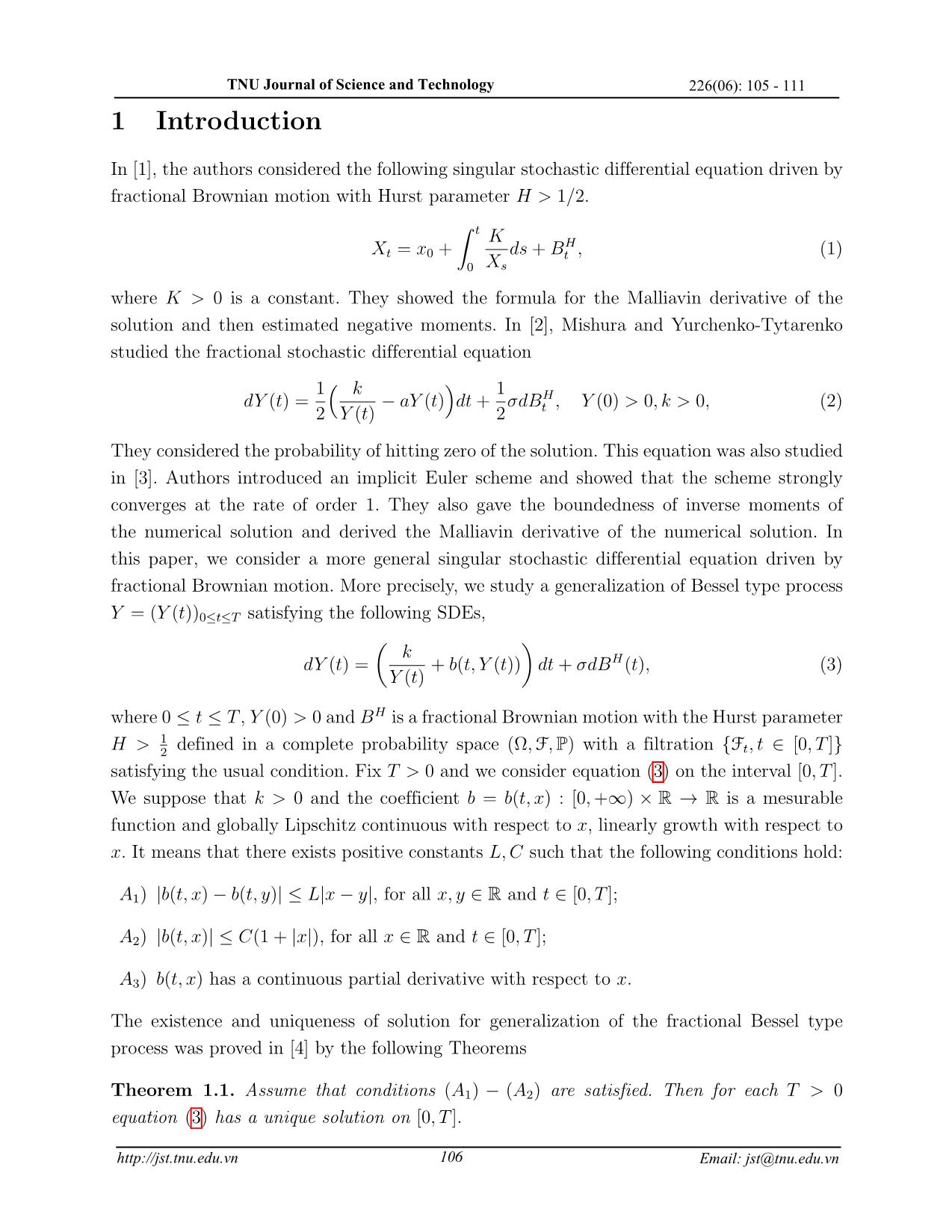
Trang 2
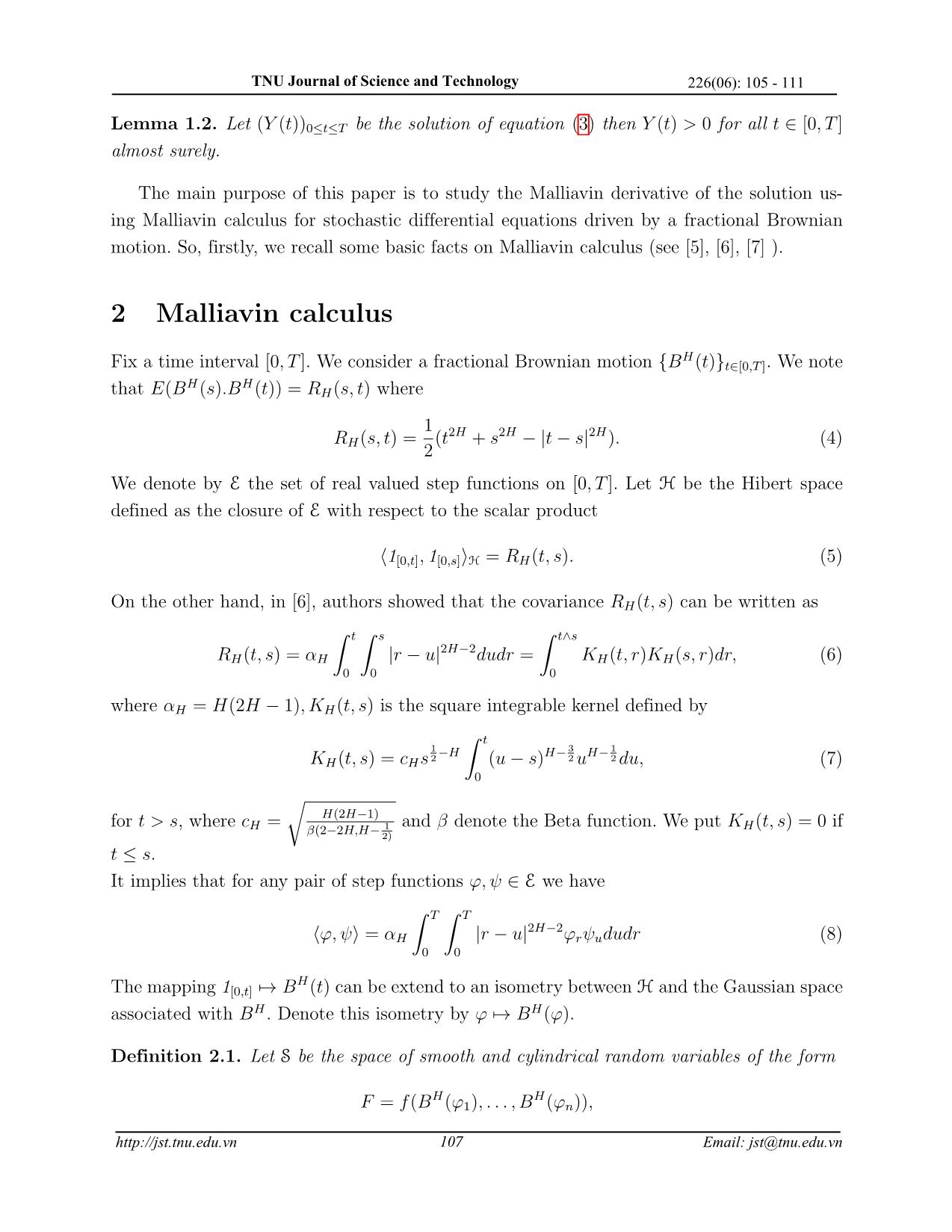
Trang 3
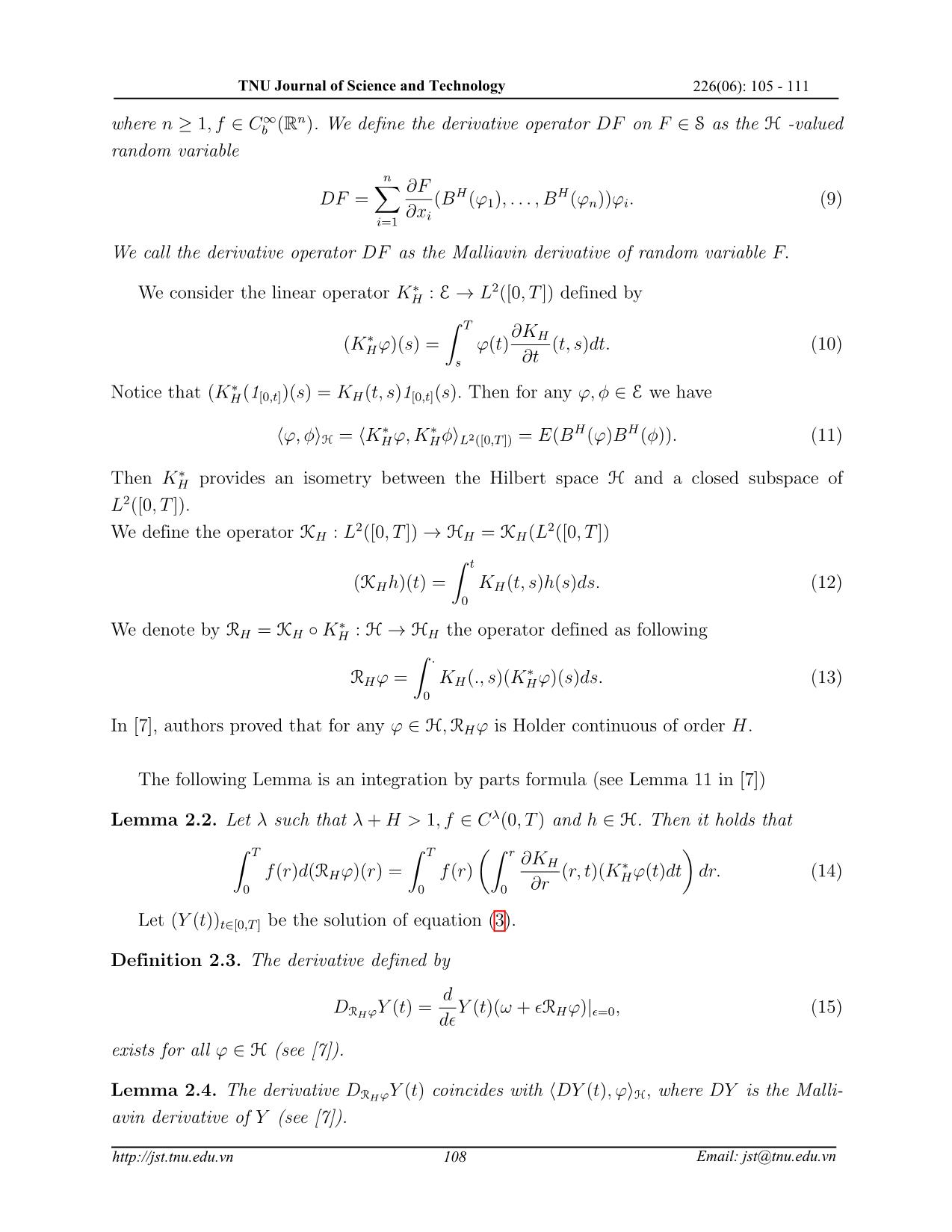
Trang 4
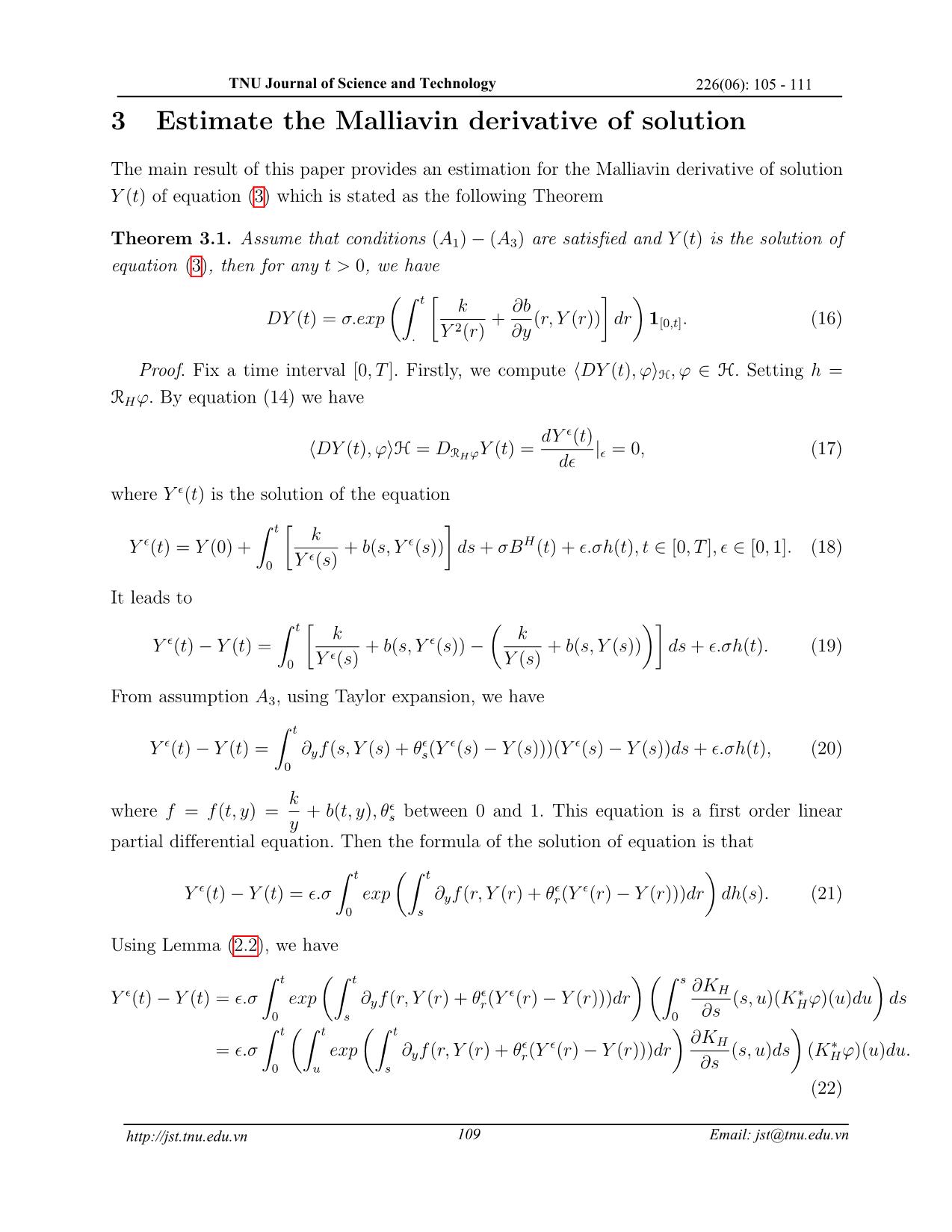
Trang 5

Trang 6
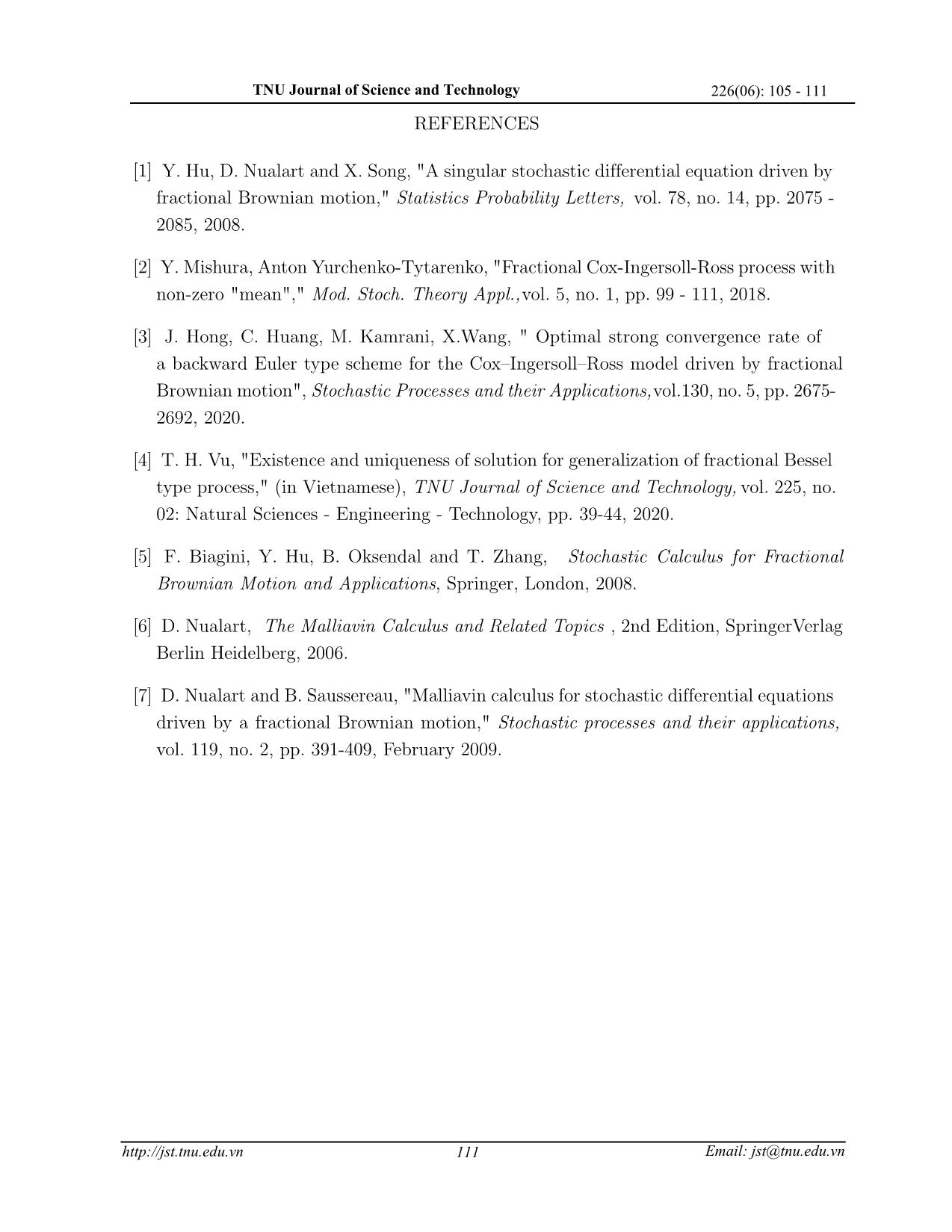
Trang 7
Tóm tắt nội dung tài liệu: Đạo hàm Malliavin của quá trình Bessel phân thứ dạng tổng quát
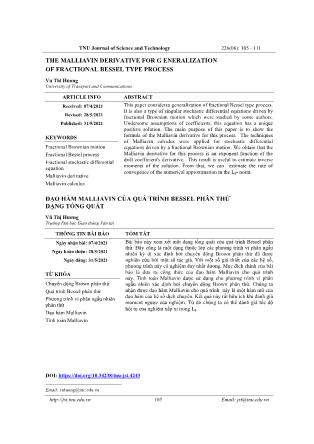
TNU Journal of Science and Technology 226(06): 105 - 111
THE MALLIAVIN DERIVATIVE FOR G ENERALIZATION
OF FRACTIONAL BESSEL TYPE PROCESS
Vu Thi Huong*
University of Transport and Communications
ARTICLE INFO ABSTRACT
Received: 07/4/2021 This paper considersa generalization of fractional Bessel type process.
It is also a type of singular stochastic differential equations driven by
Revised: 28/5/2021 fractional Brownian motion which were studied by some authors.
Published: 31/5/2021 Undersome assumptions of coefficients, this equation has a unique
positive solution. The main purpose of this paper is to show the
KEYWORDS formula of the Malliavin derivative for this process. The techniques
of Malliavin calculus were applied for stochastic differential
Fractional Brownian motion equations driven by a fractional Brownian motion. We obtain that the
Fractional Bessel process Malliavin derivative for this process is an exponent function of the
Fractional stochastic differential drift coefficient's derivative. This result is useful to estimate inverse
equation moments of the solution. From that, we can estimate the rate of
convegence of the numerical approximation in the Lp- norm.
Malliavin derivative
Malliavin calculus
ĐẠO HÀM MALLIAVIN CỦA QUÁ TRÌNH BESSEL PHÂN THỨ
DẠNG TỔNG QUÁT
Vũ Thị Hương
Trường Đại học Giao thông Vận tải
THÔNG TIN BÀI BÁO TÓM TẮT
Ngày nhận bài: 07/4/2021 Bài báo này xem xét một dạng tổng quát của quá trình Bessel phân
thứ. Đây cũng là một dạng thuộc lớp các phương trình vi phân ngẫu
Ngày hoàn thiện: 28/5/2021 nhiên kỳ dị xác định bởi chuyển động Brown phân thứ đã được
Ngày đăng: 31/5/2021 nghiên cứu bởi một số tác giả. Với một số giả thiết của các hệ số,
phương trình này có nghiệm duy nhất dương. Mục đích chính của bài
TỪ KHÓA báo là đưa ra công thức của đạo hàm Malliavin cho quá trình
này. Tính toán Malliavin được sử dụng cho phương trình vi phân
Chuyển động Brown phân thứ ngẫu nhiên xác định bởi chuyển động Brown phân thứ. Chúng ta
Quá trình Bessel phân thứ nhận được đạo hàm Malliavin cho quá trình này là một hàm mũ của
Phương trình vi phân ngẫu nhiên đạo hàm của hệ số dịch chuyển. Kết quả này rất hữu ích khi đánh giá
phân thứ moment ngược của nghiệm. Từ đó chúng ta có thể đánh giá tốc độ
hội tụ của nghiệm xấp xỉ trong Lp.
Đạo hàm Malliavin
Tính toán Malliavin
DOI: https://doi.org/10.34238/tnu-jst.4243
Email: vthuong@utc.edu.vn
105 Email: jst@tnu.edu.vn
TNU Journal of Science and Technology 226(06): 105 - 111
1 Introduction
In [1], the authors considered the following singular stochastic differential equation driven by
fractional Brownian motion with Hurst parameter H > 1/2.
Z t
K H
Xt = x0 + ds + Bt , (1)
0 Xs
where K > 0 is a constant. They showed the formula for the Malliavin derivative of the
solution and then estimated negative moments. In [2], Mishura and Yurchenko-Tytarenko
studied the fractional stochastic differential equation
1 k 1
dY (t) = − aY (t) dt + σdBH ,Y (0) > 0, k > 0, (2)
2 Y (t) 2 t
They considered the probability of hitting zero of the solution. This equation was also studied
in [3]. Authors introduced an implicit Euler scheme and showed that the scheme strongly
converges at the rate of order 1. They also gave the boundedness of inverse moments of
the numerical solution and derived the Malliavin derivative of the numerical solution. In
this paper, we consider a more general singular stochastic differential equation driven by
fractional Brownian motion. More precisely, we study a generalization of Bessel type process
Y = (Y (t))0≤t≤T satisfying the following SDEs,
k
dY (t) = + b(t, Y (t)) dt + σdBH (t), (3)
Y (t)
where 0 ≤ t ≤ T , Y (0) > 0 and BH is a fractional Brownian motion with the Hurst parameter
1
H > 2 defined in a complete probability space (Ω, F, P) with a filtration {Ft, t ∈ [0,T ]}
satisfying the usual condition. Fix T > 0 and we consider equation (3) on the interval [0,T ].
We suppose that k > 0 and the coefficient b = b(t, x) : [0, +∞) × R → R is a mesurable
function and globally Lipschitz continuous with respect to x, linearly growth with respect to
x. It means that there exists positive constants L, C such that the following conditions hold:
A1) |b(t, x) − b(t, y)| ≤ L|x − y|, for all x, y ∈ R and t ∈ [0,T ];
A2) |b(t, x)| ≤ C(1 + |x|), for all x ∈ R and t ∈ [0,T ];
A3) b(t, x) has a continuous partial derivative with respect to x.
The existence and uniqueness of solution for generalization of the fractional Bessel type
process was proved in [4] by the following Theorems
Theorem 1.1. Assume that conditions (A1) − (A2) are satisfied. Then for each T > 0
equation (3) has a unique solution on [0,T ].
106 Email: jst@tnu.edu.vn
TNU Journal of Science and Technology 226(06): 105 - 111
Lemma 1.2. Let (Y (t))0≤t≤T be the solution of equation (3) then Y (t) > 0 for all t ∈ [0,T ]
almost surely.
The main purpose of this paper is to study the Malliavin derivative of the solution us-
ing Malliavin calculus for stochastic differential equations driven by a fractional Brownian
motion. So, firstly, we recall some basic facts on Malliavin calculus (see [5], [6], [7] ).
2 Malliavin calculus
H
Fix a time interval [0,T ]. We consider a fractional Brownian motion {B (t)}t∈[0,T ]. We note
H H
that E(B (s).B (t)) = RH (s, t) where
1
R (s, t) = (t2H + s2H − |t − s|2H ). (4)
H 2
We denote by E the set of real valued step functions on [0,T ]. Let H be the Hibert space
defined as the closure of E with respect to the scalar product
h1[0,t], 1[0,s]iH = RH (t, s). (5)
On the other hand, in [6], authors showed that the covariance RH (t, s) can be written as
Z t Z s Z t∧s
2H−2
RH (t, s) = αH |r − u| dudr = KH (t, r)KH (s, r)dr, (6)
0 0 0
where αH = H(2H − 1),KH (t, s) is the square integrable kernel defined by
Z t
1 −H H− 3 H− 1
KH (t, s) = cH s 2 (u − s) 2 u 2 du, (7)
0
r
H(2H−1)
for t > s, where cH = 1 and β denote the Beta function. We put KH (t, s) = 0 if
β(2−2H,H− 2)
t ≤ s.
It implies that for any pair of step functions ϕ, ψ ∈ E we have
Z T Z T
2H−2
hϕ, ψi = αH |r − u| ϕrψududr (8)
0 0
H
The mapping 1[0,t] 7→ B (t) can be extend to an isometry between H and the Gaussian space
associated with BH . Denote this isometry by ϕ 7→ BH (ϕ).
Definition 2.1. Let S be the space of smooth and cylindrical random variables of the form
H H
F = f(B (ϕ1),...,B (ϕn)),
107 Email: jst@tnu.edu.vn
TNU Journal of Science and Technology 226(06): 105 - 111
∞ n
where n ≥ 1, f ∈ Cb (R ). We define the derivative operator DF on F ∈ S as the H -valued
random variable
n
X ∂F
DF = (BH (ϕ ),...,BH (ϕ ))ϕ . (9)
∂x 1 n i
i=1 i
We call the derivative operator DF as the Malliavin derivative of random variable F.
∗ 2
We consider the linear operator KH : E → L ([0,T ]) defined by
Z T
∗ ∂KH
(KH ϕ)(s) = ϕ(t) (t, s)dt. (10)
s ∂t
∗
Notice that (KH (1[0,t])(s) = KH (t, s)1[0,t](s). Then for any ϕ, φ ∈ E we have
∗ ∗ H H
hϕ, φiH = hKH ϕ, KH φiL2([0,T ]) = E(B (ϕ)B (φ)). (11)
∗
Then KH provides an isometry between the Hilbert space H and a closed subspace of
L2([0,T ]).
2 2
We define the operator KH : L ([0,T ]) → HH = KH (L ([0,T ])
Z t
(KH h)(t) = KH (t, s)h(s)ds. (12)
0
∗
We denote by RH = KH ◦ KH : H → HH the operator defined as following
Z .
∗
RH ϕ = KH (., s)(KH ϕ)(s)ds. (13)
0
In [7], authors proved that for any ϕ ∈ H, RH ϕ is Holder continuous of order H.
The following Lemma is an integration by parts formula (see Lemma 11 in [7])
Lemma 2.2. Let λ such that λ + H > 1, f ∈ Cλ(0,T ) and h ∈ H. Then it holds that
Z T Z T Z r
∂KH ∗
f(r)d(RH ϕ)(r) = f(r) (r, t)(KH ϕ(t)dt dr. (14)
0 0 0 ∂r
Let (Y (t))t∈[0,T ] be the solution of equation (3).
Definition 2.3. The derivative defined by
d
D Y (t) = Y (t)(ω + R ϕ)| , (15)
RH ϕ d H =0
exists for all ϕ ∈ H (see [7]).
Lemma 2.4. The derivative DRH ϕY (t) coincides with hDY (t), ϕiH, where DY is the Malli-
avin derivative of Y (see [7]).
108 Email: jst@tnu.edu.vn
TNU Journal of Science and Technology 226(06): 105 - 111
3 Estimate the Malliavin derivative of solution
The main result of this paper provides an estimation for the Malliavin derivative of solution
Y (t) of equation (3) which is stated as the following Theorem
Theorem 3.1. Assume that conditions (A1) − (A3) are satisfied and Y (t) is the solution of
equation (3), then for any t > 0, we have
Z t k ∂b
DY (t) = σ.exp 2 + (r, Y (r)) dr 1[0,t]. (16)
. Y (r) ∂y
Proof. Fix a time interval [0,T ]. Firstly, we compute hDY (t), ϕiH, ϕ ∈ H. Setting h =
RH ϕ. By equation (14) we have
dY (t)
hDY (t), ϕiH = D Y (t) = | = 0, (17)
RH ϕ d
where Y (t) is the solution of the equation
Z t
k H
Y (t) = Y (0) + + b(s, Y (s)) ds + σB (t) + .σh(t), t ∈ [0,T ], ∈ [0, 1]. (18)
0 Y (s)
It leads to
Z t
k k
Y (t) − Y (t) = + b(s, Y (s)) − + b(s, Y (s)) ds + .σh(t). (19)
0 Y (s) Y (s)
From assumption A3, using Taylor expansion, we have
Z t
Y (t) − Y (t) = ∂yf(s, Y (s) + θs(Y (s) − Y (s)))(Y (s) − Y (s))ds + .σh(t), (20)
0
k
where f = f(t, y) = + b(t, y), θ between 0 and 1. This equation is a first order linear
y s
partial differential equation. Then the formula of the solution of equation is that
Z t Z t
Y (t) − Y (t) = .σ exp ∂yf(r, Y (r) + θr(Y (r) − Y (r)))dr dh(s). (21)
0 s
Using Lemma (2.2), we have
Z t Z t Z s
∂KH ∗
Y (t) − Y (t) = .σ exp ∂yf(r, Y (r) + θr(Y (r) − Y (r)))dr (s, u)(KH ϕ)(u)du ds
0 s 0 ∂s
Z t Z t Z t
∂KH ∗
= .σ exp ∂yf(r, Y (r) + θr(Y (r) − Y (r)))dr (s, u)ds (KH ϕ)(u)du.
0 u s ∂s
(22)
109 Email: jst@tnu.edu.vn
TNU Journal of Science and Technology 226(06): 105 - 111
∗
By the definition of the operator KH we have
Z t Z t
∗ ∗
Y (t) − Y (t) = .σ (KH ϕ)(u) KH exp ∂yf(r, Y (r) + θr(Y (r) − Y (r)))dr (u)du
0 .
Z t
= .σhϕ, exp ∂yf(r, Y (r) + θr(Y (r) − Y (r)))dr iH
.
Z t Z t Z t
2H−2
= αH .σ ϕ(s)exp ∂yf(r, Y (r) + θr(Y (r) − Y (r)))dr |s − u| duds.
0 0 u
By assumption that k > 0 we have
−k
∂ f(t, y) = + ∂ b(t, y) ≤ ∂yb(t, y).
y y2 y
But from assumption A1,
b(t, x) − b(t, y) |b(t, x) − b(t, y)|
≤ ≤ L.
x − y |x − y|
Then ∂yb(t, y) ≤ L. It mean that ∂yf(t, y) is bounded. As a consequence,
Z t Z t Z t
Y (t) − Y (t) 2H−2
lim =αH .σ ϕ(s)exp ∂yf(r, Y (r)dr |s − u| duds
0 0 u
Z t
= σhϕ, exp ∂yf(r, Y (r)dr 1[0,t]iH,
.
where the limit holds almost surely and in L2(Ω).
Together with equation (16), it leads to
Z t
DY (t) = σ.exp ∂yf(r, Y (r)dr 1[0,t]
.
Z t k ∂b
= σ.exp 2 + (r, Y (r)) dr 1[0,t].
. Y (r) ∂y
We obtain the formula of the Malliavin derivative DY .
4 Conclusion
The main result of this paper is to prove the formula of the Malliavin derivative for a type of
singular process driven fractional Brownian motion. From this formula, in the future, we can
estimate inverse moments of this process which is necessary in showing the rate convegence
of the numerical approximation in the Lp - norm.
110 Email: jst@tnu.edu.vn
TNU Journal of Science and Technology 226(06): 105 - 111
REFERENCES
[1] Y. Hu, D. Nualart and X. Song, "A singular stochastic differential equation driven by
fractional Brownian motion," Statistics Probability Letters, vol. 78, no. 14, pp. 2075 -
2085, 2008.
[2] Y. Mishura, Anton Yurchenko-Tytarenko, "Fractional Cox-Ingersoll-Ross process with
non-zero "mean"," Mod. Stoch. Theory Appl.,vol. 5, no. 1, pp. 99 - 111, 2018.
[3] J. Hong, C. Huang, M. Kamrani, X.Wang, " Optimal strong convergence rate of
a backward Euler type scheme for the Cox–Ingersoll–Ross model driven by fractional
Brownian motion", Stochastic Processes and their Applications,vol.130, no. 5, pp. 2675-
2692, 2020.
[4] T. H. Vu, "Existence and uniqueness of solution for generalization of fractional Bessel
type process," (in Vietnamese), TNU Journal of Science and Technology, vol. 225, no.
02: Natural Sciences - Engineering - Technology, pp. 39-44, 2020.
[5] F. Biagini, Y. Hu, B. Oksendal and T. Zhang, Stochastic Calculus for Fractional
Brownian Motion and Applications, Springer, London, 2008.
[6] D. Nualart, The Malliavin Calculus and Related Topics , 2nd Edition, SpringerVerlag
Berlin Heidelberg, 2006.
[7] D. Nualart and B. Saussereau, "Malliavin calculus for stochastic differential equations
driven by a fractional Brownian motion," Stochastic processes and their applications,
vol. 119, no. 2, pp. 391-409, February 2009.
111 Email: jst@tnu.edu.vn File đính kèm:
 dao_ham_malliavin_cua_qua_trinh_bessel_phan_thu_dang_tong_qu.pdf
dao_ham_malliavin_cua_qua_trinh_bessel_phan_thu_dang_tong_qu.pdf

